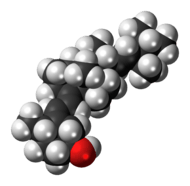Dihydrotachysterol
Not to be confused with Dihydrotestosterone.
 | |
 | |
| Clinical data | |
|---|---|
| AHFS/Drugs.com | Micromedex Detailed Consumer Information |
| MedlinePlus | a682335 |
| ATC code | A11CC02 (WHO) |
| Identifiers | |
| |
| CAS Number |
67-96-9 |
| PubChem (CID) | 5311071 |
| DrugBank |
DB01070 |
| ChemSpider |
4470607 |
| UNII |
R5LM3H112R |
| KEGG |
D00299 |
| ChEBI |
CHEBI:4591 |
| ECHA InfoCard | 100.000.611 |
| Chemical and physical data | |
| Formula | C28H46O |
| Molar mass | 398.664 g/mol |
| 3D model (Jmol) | Interactive image |
| |
| |
| (verify) | |
Dihydrotachysterol (DHT) is a synthetic vitamin D analog activated in the liver that does not require renal hydroxylation like vitamin D2 (ergocalciferol) and vitamin D3 (cholecalciferol). DHT has a rapid onset of action (2 hours), a shorter half-life, and a greater effect on mineralization of bone salts than does vitamin D.[1]
References
- ↑ R. Gagnon; G. W. Ogden; G. Just; M. Kaye (1974). "Comparison of Dihydrotachysterol and 5,6-trans Vitamin D3 on Intestinal Calcium Absorption in Patients with Chronic Renal Failure". Canadian Journal of Physiology and Pharmacology. 52 (2): 272–274. doi:10.1139/y74-037. PMID 4365509.
This article is issued from Wikipedia - version of the 10/12/2016. The text is available under the Creative Commons Attribution/Share Alike but additional terms may apply for the media files.